engine YAMAHA YBR125 2004 Owner's Manual
[x] Cancel search | Manufacturer: YAMAHA, Model Year: 2004, Model line: YBR125, Model: YAMAHA YBR125 2004Pages: 83, PDF Size: 3.16 MB
Page 39 of 83

5-4 Tips for reducing fuel consumption
Your motorcycleís fuel consumption depends to a large
extent on your riding style. The following tips can help reduce
fuel consumption.
1. Warm up the engine before riding.
2. Turn off the starter lever as soon as possible.
3. Shift up swiftly and avoid high engine speeds during
acceleration.
4. Do not double-clutch or rev the engine while shifting down
and avoid high engine speeds with no load engine.
5. Turn off the engine instead of letting it idle for an extended
lenght of time, i.e. in traffic jams, at traffic lights or railroad
crossings.Engine Break-in
There is never a more important period in the life of your
motorcycle than the period 1.000Km. For this reason we
ask that you carefully read the following material. Because
the engine is brand new, you must not put an excessive
load on it for the first several hours of running.
During this period, prolonged full throttle operation, or any
condition which might result in excessive heating of the
engine must be avoided.
1. 0 ~ 150 Km:
Avoid operation above 1/3 throttle. Stop the engine and
let it cool for 5 to 10 minutes after every hour of
operation. Vary the speed of the motorcycle from time
to time. Do not operate it at one set throttle position.
5-4 Tips for reducing fuel consumption
Your motorcycleís fuel consumption depends to a large
extent on your riding style. The following tips can help reduce
fuel consumption.
1. Warm up the engine before riding.
2. Turn off the starter lever as soon as possible.
3. Shift up swiftly and avoid high engine speeds during
acceleration.
4. Do not double-clutch or rev the engine while shifting down
and avoid high engine speeds with no load engine.
5. Turn off the engine instead of letting it idle for an extended
lenght of time, i.e. in traffic jams, at traffic lights or railroad
crossings.Engine Break-in
There is never a more important period in the life of your
motorcycle than the period 1.000Km. For this reason we
ask that you carefully read the following material. Because
the engine is brand new, you must not put an excessive
load on it for the first several hours of running.
During this period, prolonged full throttle operation, or any
condition which might result in excessive heating of the
engine must be avoided.
1. 0 ~ 150 Km:
Avoid operation above 1/3 throttle. Stop the engine and
let it cool for 5 to 10 minutes after every hour of
operation. Vary the speed of the motorcycle from time
to time. Do not operate it at one set throttle position.
Page 40 of 83
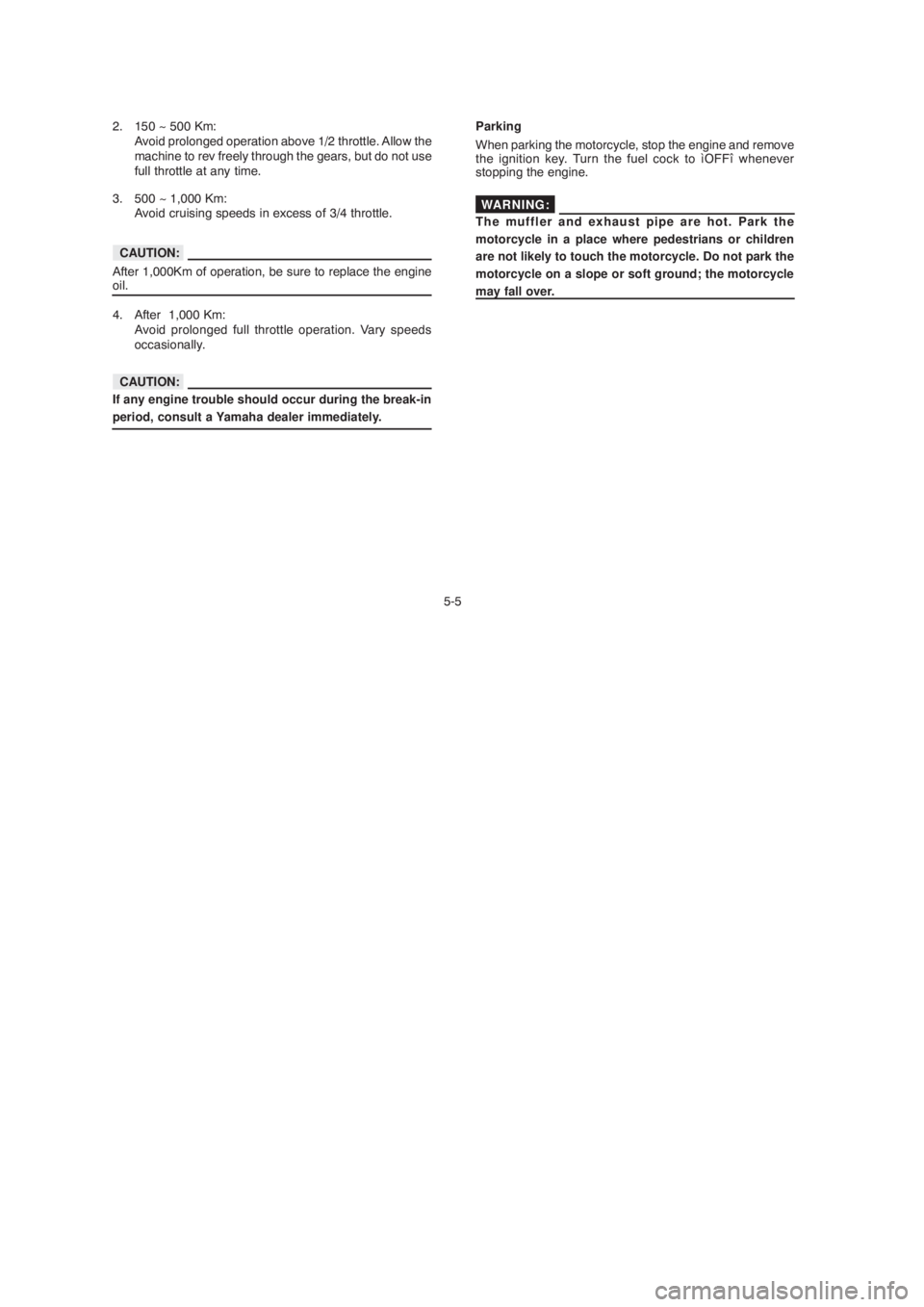
5-5 2. 150 ~ 500 Km:
Avoid prolonged operation above 1/2 throttle. Allow the
machine to rev freely through the gears, but do not use
full throttle at any time.
3. 500 ~ 1,000 Km:
Avoid cruising speeds in excess of 3/4 throttle.
After 1,000Km of operation, be sure to replace the engine
oil.
4. After 1,000 Km:
Avoid prolonged full throttle operation. Vary speeds
occasionally.
If any engine trouble should occur during the break-in
period, consult a Yamaha dealer immediately.Parking
When parking the motorcycle, stop the engine and remove
the ignition key. Turn the fuel cock to ìOFFî whenever
stopping the engine.
The muffler and exhaust pipe are hot. Park the
motorcycle in a place where pedestrians or children
are not likely to touch the motorcycle. Do not park the
motorcycle on a slope or soft ground; the motorcycle
may fall over.
CAUTION:
CAUTION:
WARNING:
5-5 2. 150 ~ 500 Km:
Avoid prolonged operation above 1/2 throttle. Allow the
machine to rev freely through the gears, but do not use
full throttle at any time.
3. 500 ~ 1,000 Km:
Avoid cruising speeds in excess of 3/4 throttle.
After 1,000Km of operation, be sure to replace the engine
oil.
4. After 1,000 Km:
Avoid prolonged full throttle operation. Vary speeds
occasionally.
If any engine trouble should occur during the break-in
period, consult a Yamaha dealer immediately.Parking
When parking the motorcycle, stop the engine and remove
the ignition key. Turn the fuel cock to ìOFFî whenever
stopping the engine.
The muffler and exhaust pipe are hot. Park the
motorcycle in a place where pedestrians or children
are not likely to touch the motorcycle. Do not park the
motorcycle on a slope or soft ground; the motorcycle
may fall over.
CAUTION:
CAUTION:
WARNING:
Page 43 of 83
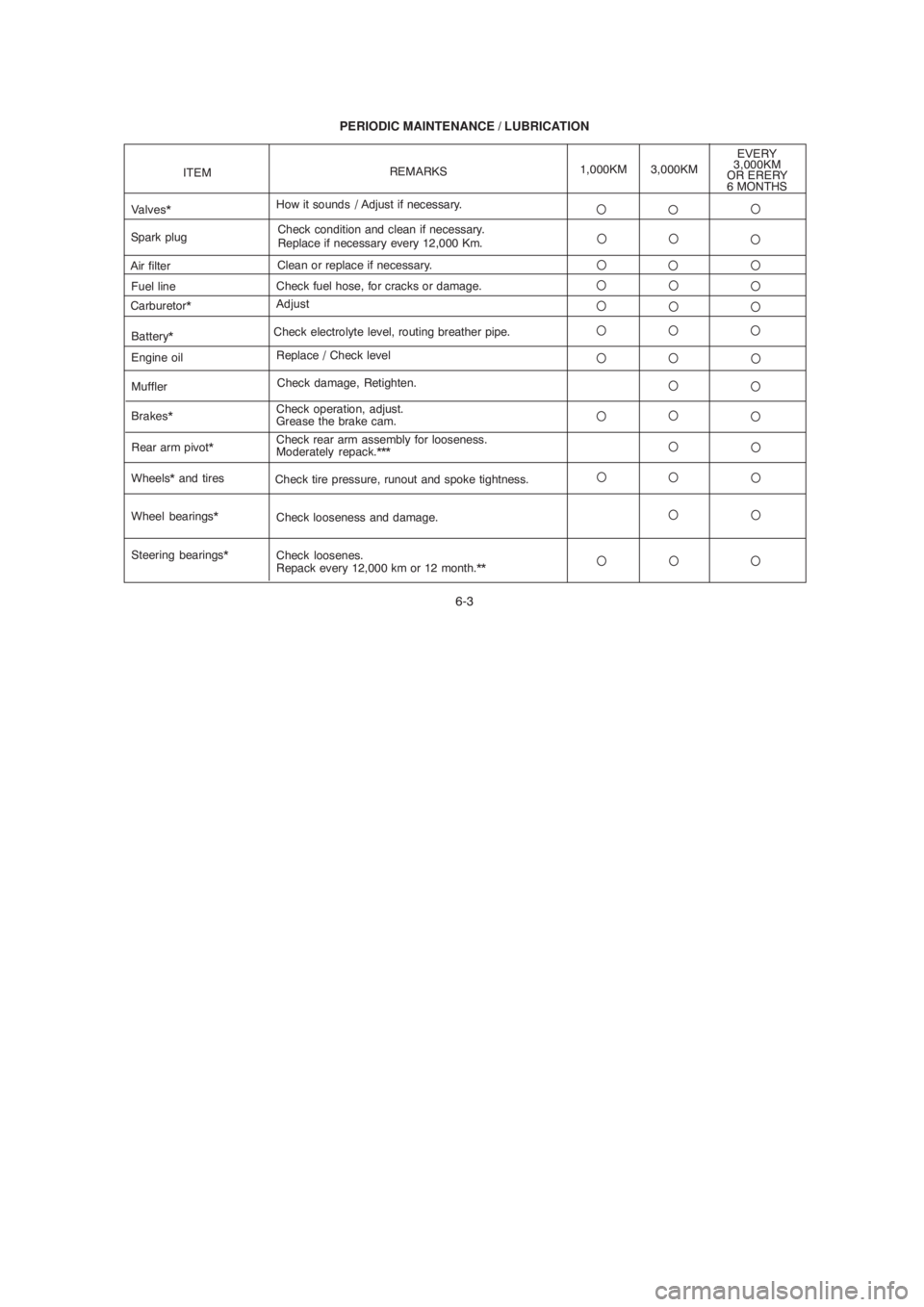
6-3 PERIODIC MAINTENANCE / LUBRICATION
Wheel bearings* Battery*
Check looseness and damage. Check electrolyte level, routing breather pipe.
ITEM
How it sounds
/ Adjust if necessary.
REMARKS1,000KM
Fuel line Air filter
Carburetor*Valves*
Muffler
Brakes* Engine oil
Steering bearings* Rear arm pivot*Check fuel hose, for cracks or damage.Clean or replace if necessary.
Adjust
Check damage, Retighten.
Check operation, adjust.
Grease the brake cam. Replace / Check level
Check loosenes.
Repack every 12,000 km or 12 month.** Check rear arm assembly for looseness.
Moderately repack.***
EVERY
3,000KM
OR ERERY
6 MONTHS
Wheels* and tires
Check tire pressure, runout and spoke tightness.
Spark plugCheck condition and clean if necessary.
Replace if necessary every 12,000 Km.
3,000KM
6-3 PERIODIC MAINTENANCE / LUBRICATION
Wheel bearings* Battery*
Check looseness and damage. Check electrolyte level, routing breather pipe.
ITEM
How it sounds
/ Adjust if necessary.
REMARKS1,000KM
Fuel line Air filter
Carburetor*Valves*
Muffler
Brakes* Engine oil
Steering bearings* Rear arm pivot*Check fuel hose, for cracks or damage.Clean or replace if necessary.
Adjust
Check damage, Retighten.
Check operation, adjust.
Grease the brake cam. Replace / Check level
Check loosenes.
Repack every 12,000 km or 12 month.** Check rear arm assembly for looseness.
Moderately repack.***
EVERY
3,000KM
OR ERERY
6 MONTHS
Wheels* and tires
Check tire pressure, runout and spoke tightness.
Spark plugCheck condition and clean if necessary.
Replace if necessary every 12,000 Km.
3,000KM
Page 45 of 83

Torque specifications
Use a torque wrench to tighten these items. It is
recommended that these items be checked occasionally,
specially before a long trip. Always check the tightness of
these items whenever they are loosened for any reason.
6-5
Torque
Nm
kgf.m Item
Spark plug
Engine oil drain plug
Oil check bolt
Front wheel axle nut
Rear wheel axle nut
12,5
20
7
45
911,25
2,0
0,7
4,5
9,1
A
(Nut)
10 mm
12 mm
14 mm
17 mm
19 mm
22 mmB
(Bolt)
6 mm
8 mm
10 mm
12 mm
14 mm
16 mmGeneral torque especifications
Nm
6
15
30
55
85
130kgf.m
0,6
1,5
3,0
5,5
8,5
13,0lbf. ft
4,3
11
22
40
61
94
lbf.ft
9.0
14.5
5.0
32.5
66
Torque specifications
Use a torque wrench to tighten these items. It is
recommended that these items be checked occasionally,
specially before a long trip. Always check the tightness of
these items whenever they are loosened for any reason.
6-5
Torque
Nm
kgf.m Item
Spark plug
Engine oil drain plug
Oil check bolt
Front wheel axle nut
Rear wheel axle nut
12,5
20
7
45
911,25
2,0
0,7
4,5
9,1
A
(Nut)
10 mm
12 mm
14 mm
17 mm
19 mm
22 mmB
(Bolt)
6 mm
8 mm
10 mm
12 mm
14 mm
16 mmGeneral torque especifications
Nm
6
15
30
55
85
130kgf.m
0,6
1,5
3,0
5,5
8,5
13,0lbf. ft
4,3
11
22
40
61
94
lbf.ft
9.0
14.5
5.0
32.5
66
Page 46 of 83

6-6
1. Engine oil filler cap
1. Maximum mark 2.Minimum mark
Engine oil
1. Oil level measurement
a. Place the motorcycle on a level place and hold it in an
upright position. Warm up the engine for several
minutes.
NOTE:
Be sure the motorcycle is positioned straight up when
checking the oil level. A slight tilt toward the side can result
in false readings.
b. With the engine stopped, with the engine stopped,
unscrew the oil filler cap/ dispstick and rest it on the
threads of the ok.
NOTE:
Wait a few minutes until the oil level settles before checking.
c. Remove the oil filler cap/ dispstick, clean it with a dry
cloth and check the oil level.
NOTE:
To check the oil level the oil filler cap/ dispstick can not be
screwed, just lightly seated in place.
d. The oil level should be between the maximum and
minimum marks. If the level is low, add oil to raise it to the
indicated level, check for oil leakage.
6-6
1. Engine oil filler cap
1. Maximum mark 2.Minimum mark
Engine oil
1. Oil level measurement
a. Place the motorcycle on a level place and hold it in an
upright position. Warm up the engine for several
minutes.
NOTE:
Be sure the motorcycle is positioned straight up when
checking the oil level. A slight tilt toward the side can result
in false readings.
b. With the engine stopped, with the engine stopped,
unscrew the oil filler cap/ dispstick and rest it on the
threads of the ok.
NOTE:
Wait a few minutes until the oil level settles before checking.
c. Remove the oil filler cap/ dispstick, clean it with a dry
cloth and check the oil level.
NOTE:
To check the oil level the oil filler cap/ dispstick can not be
screwed, just lightly seated in place.
d. The oil level should be between the maximum and
minimum marks. If the level is low, add oil to raise it to the
indicated level, check for oil leakage.
Page 47 of 83

6-7
2. Engine oil and filter replacement
a. Warm up the engine for a few minutes.
b. Stop the engine. Place an oil pan under the engine and
remove the dipstick.
c. Remove the drain plug and drain the oil.
d. Reinstall the drain plug, check if the gasket is damaged
and tighten it to the specified torque.
Tightening torque:
Drain plug:
20 N.m (2.0 kgf.m, 14.5 lbf.t)
1.Dipstick
1. Engine oil drain plug
6-7
2. Engine oil and filter replacement
a. Warm up the engine for a few minutes.
b. Stop the engine. Place an oil pan under the engine and
remove the dipstick.
c. Remove the drain plug and drain the oil.
d. Reinstall the drain plug, check if the gasket is damaged
and tighten it to the specified torque.
Tightening torque:
Drain plug:
20 N.m (2.0 kgf.m, 14.5 lbf.t)
1.Dipstick
1. Engine oil drain plug
Page 48 of 83
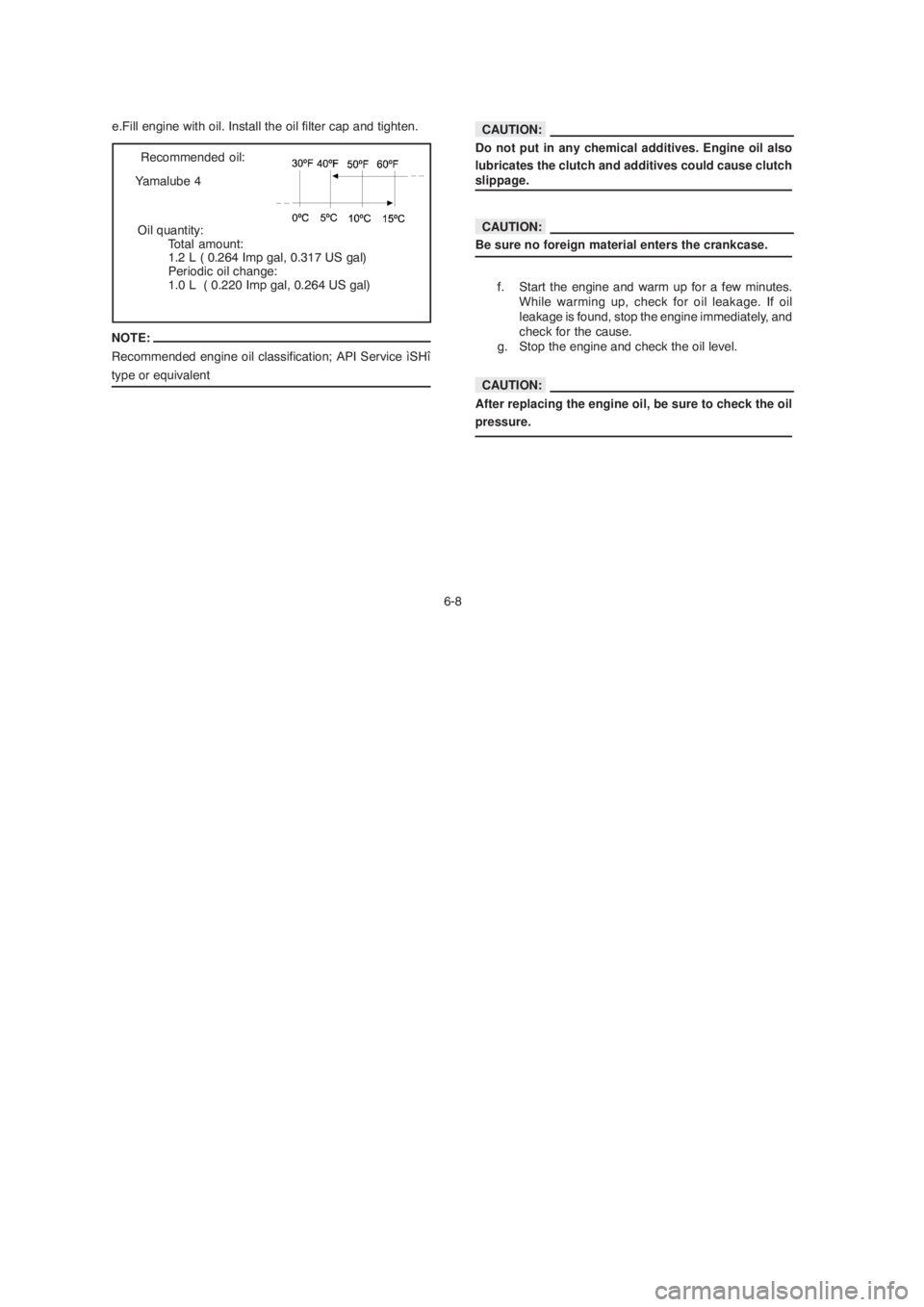
6-8 e.Fill engine with oil. Install the oil filter cap and tighten.
NOTE:
Recommended engine oil classification; API Service ìSHî
type or equivalent
Do not put in any chemical additives. Engine oil also
lubricates the clutch and additives could cause clutch
slippage.
Be sure no foreign material enters the crankcase.
f. Start the engine and warm up for a few minutes.
While warming up, check for oil leakage. If oil
leakage is found, stop the engine immediately, and
check for the cause.
g. Stop the engine and check the oil level.
After replacing the engine oil, be sure to check the oil
pressure.
Oil quantity:
Total amount:
1.2 L ( 0.264 Imp gal, 0.317 US gal)
Periodic oil change:
1.0 L ( 0.220 Imp gal, 0.264 US gal) Recommended oil:
Yamalube 4
CAUTION:
CAUTION:
CAUTION:
6-8 e.Fill engine with oil. Install the oil filter cap and tighten.
NOTE:
Recommended engine oil classification; API Service ìSHî
type or equivalent
Do not put in any chemical additives. Engine oil also
lubricates the clutch and additives could cause clutch
slippage.
Be sure no foreign material enters the crankcase.
f. Start the engine and warm up for a few minutes.
While warming up, check for oil leakage. If oil
leakage is found, stop the engine immediately, and
check for the cause.
g. Stop the engine and check the oil level.
After replacing the engine oil, be sure to check the oil
pressure.
Oil quantity:
Total amount:
1.2 L ( 0.264 Imp gal, 0.317 US gal)
Periodic oil change:
1.0 L ( 0.220 Imp gal, 0.264 US gal) Recommended oil:
Yamalube 4
CAUTION:
CAUTION:
CAUTION:
Page 49 of 83
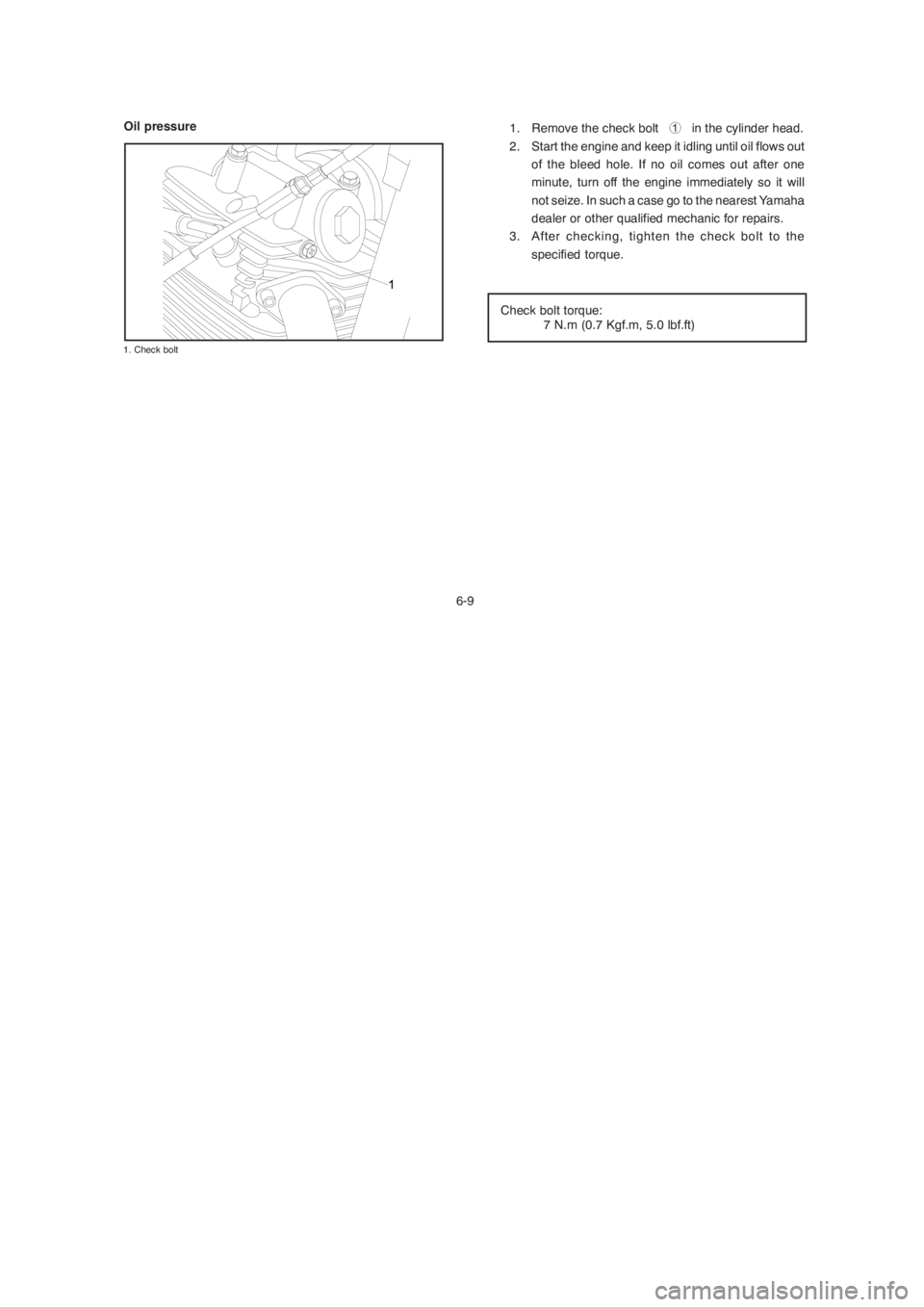
6-9 Oil pressure
1. Remove the check bolt 1 in the cylinder head.
2. Start the engine and keep it idling until oil flows out
of the bleed hole. If no oil comes out after one
minute, turn off the engine immediately so it will
not seize. In such a case go to the nearest Yamaha
dealer or other qualified mechanic for repairs.
3. After checking, tighten the check bolt to the
specified torque.
Check bolt torque:
7 N.m (0.7 Kgf.m, 5.0 lbf.ft)
1. Check bolt
6-9 Oil pressure
1. Remove the check bolt 1 in the cylinder head.
2. Start the engine and keep it idling until oil flows out
of the bleed hole. If no oil comes out after one
minute, turn off the engine immediately so it will
not seize. In such a case go to the nearest Yamaha
dealer or other qualified mechanic for repairs.
3. After checking, tighten the check bolt to the
specified torque.
Check bolt torque:
7 N.m (0.7 Kgf.m, 5.0 lbf.ft)
1. Check bolt
Page 51 of 83

5. Remove the air filter elements from the guide and clean
them with solvent. After cleaning, remove the remaining
solvent by squeezing the air filter.
6. Apply recommended oil to the entire surface of the filter
and squeeze out the excess oil. The air filter should be
wet but not dripping.
Recommended oil:
Engine oil 20W50
7. Reinstall the air filter and lock it with the clamp.
8. Install the air filter case cover and the right side cover.
Make sure the element is properly seated in the air filter
case.
The engine should never be run without the air filter
element installed; excessive piston and/or cylinder wear
may result.
6-11
CAUTION:
CAUTION:
5. Remove the air filter elements from the guide and clean
them with solvent. After cleaning, remove the remaining
solvent by squeezing the air filter.
6. Apply recommended oil to the entire surface of the filter
and squeeze out the excess oil. The air filter should be
wet but not dripping.
Recommended oil:
Engine oil 20W50
7. Reinstall the air filter and lock it with the clamp.
8. Install the air filter case cover and the right side cover.
Make sure the element is properly seated in the air filter
case.
The engine should never be run without the air filter
element installed; excessive piston and/or cylinder wear
may result.
6-11
CAUTION:
CAUTION:
Page 52 of 83
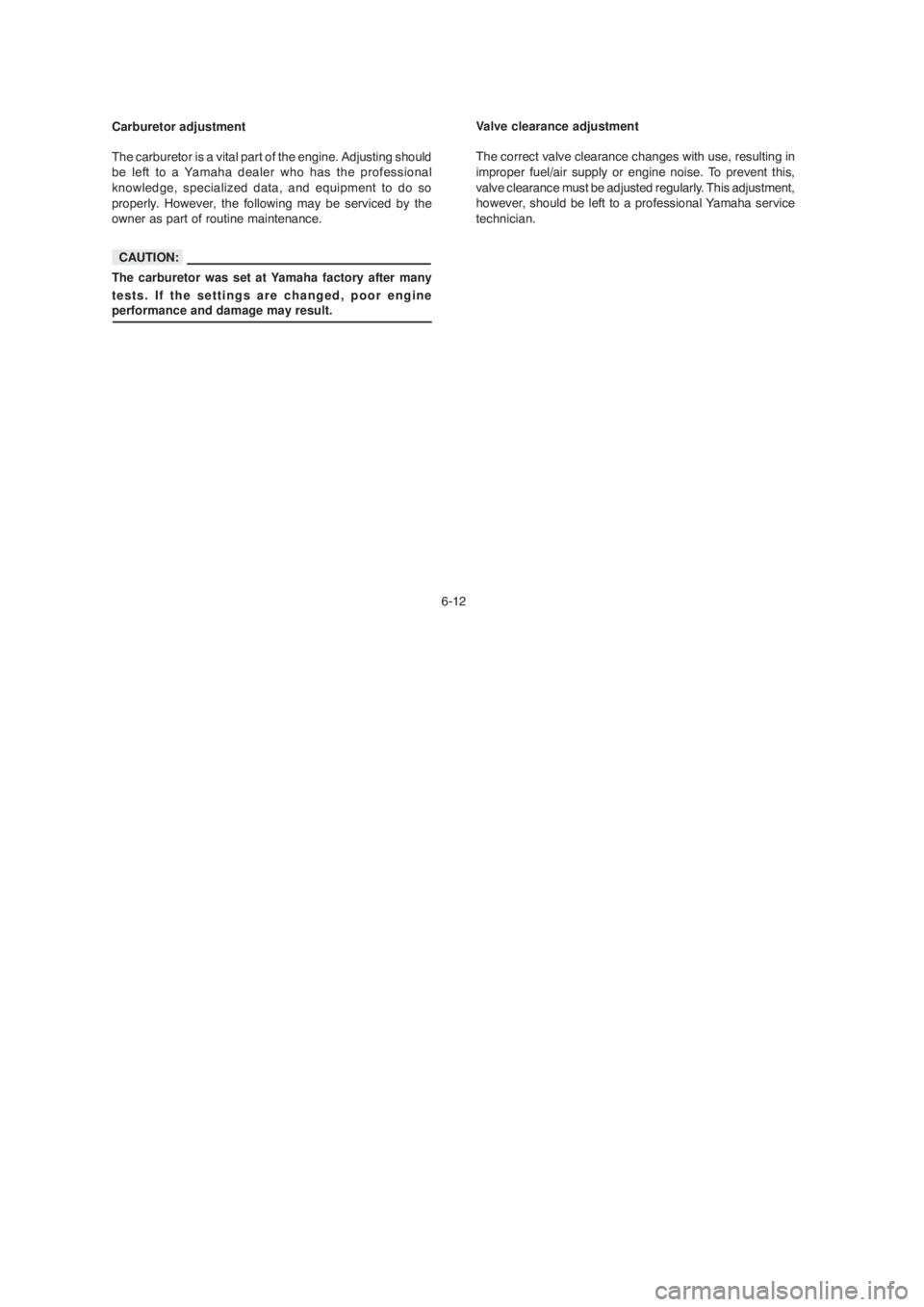
Valve clearance adjustment
The correct valve clearance changes with use, resulting in
improper fuel/air supply or engine noise. To prevent this,
valve clearance must be adjusted regularly. This adjustment,
however, should be left to a professional Yamaha service
technician. Carburetor adjustment
The carburetor is a vital part of the engine. Adjusting should
be left to a Yamaha dealer who has the professional
knowledge, specialized data, and equipment to do so
properly. However, the following may be serviced by the
owner as part of routine maintenance.
The carburetor was set at Yamaha factory after many
tests. If the settings are changed, poor engine
performance and damage may result.
6-12
CAUTION:
Valve clearance adjustment
The correct valve clearance changes with use, resulting in
improper fuel/air supply or engine noise. To prevent this,
valve clearance must be adjusted regularly. This adjustment,
however, should be left to a professional Yamaha service
technician. Carburetor adjustment
The carburetor is a vital part of the engine. Adjusting should
be left to a Yamaha dealer who has the professional
knowledge, specialized data, and equipment to do so
properly. However, the following may be serviced by the
owner as part of routine maintenance.
The carburetor was set at Yamaha factory after many
tests. If the settings are changed, poor engine
performance and damage may result.
6-12
CAUTION: